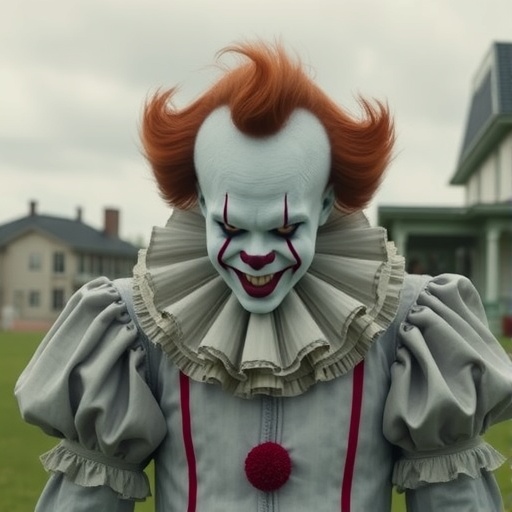HBO’s ‘It: Welcome to Derry‘ Premieres Today: Bill Skarsgård’s Pennywise Haunts 1960s Maine in Stephen King Prequel
In a chilling expansion of one of horror’s most iconic universes, HBO’s It: Welcome to Derry makes its highly anticipated TV premiere today, plunging viewers back into the eerie town of Derry, Maine, decades before the events of the blockbuster It films. As the prequel series unfolds, Bill Skarsgård reprises his role as the shape-shifting clown Pennywise, delivering fresh terrors rooted in Stephen King’s masterful 1986 novel. This HBO venture promises to unearth the origins of the ancient evil lurking beneath Derry’s surface, captivating fans with a blend of nostalgia, dread, and groundbreaking storytelling.
- Unveiling Derry’s Forgotten Horrors: The Prequel’s Ties to Stephen King’s Masterpiece
- Bill Skarsgård’s Pennywise: A Clown Reborn for HBO’s Small-Screen Nightmares
- Crafting Atmospheric Terror: HBO’s Production Journey Through 1960s Derry
- Fan Frenzy and Critical Anticipation: What to Expect from the TV Premiere
The series arrives at a pivotal moment for King’s adaptations, following the massive success of the 2017 and 2019 It movies, which grossed over $1.1 billion worldwide. With nine episodes slated for its first season, It: Welcome to Derry not only revives the Losers’ Club legacy but also introduces new characters entangled in Pennywise’s web of fear. Directed by acclaimed filmmakers like Andy Muschietti, who helmed the original films, this TV premiere marks HBO’s bold foray into King’s multiverse, potentially setting the stage for even more interconnected tales.
Unveiling Derry’s Forgotten Horrors: The Prequel’s Ties to Stephen King’s Masterpiece
Stephen King’s It has long been a cornerstone of modern horror, selling over 30 million copies since its release and inspiring a cultural phenomenon that spans books, miniseries, and films. The novel’s dual timeline—spanning the 1950s innocence of childhood and the 1980s grit of adulthood—has mesmerized readers with its exploration of fear, friendship, and the supernatural. Now, It: Welcome to Derry steps into the 1960s, a lesser-explored era in King’s lore, to reveal how Pennywise first embedded itself in Derry’s psyche.
According to showrunner Andy Muschietti, who spoke at a recent press event, the series draws directly from King’s supplemental works, including the 2019 novel Dr. Sleep and various short stories that flesh out the It entity’s ancient history. “We wanted to go deeper into the town’s cursed foundation,” Muschietti explained. “Derry isn’t just a backdrop; it’s a character pulsing with malevolent energy, built on layers of tragedy from the 18th century onward.” This prequel approach allows HBO to expand the narrative without retreading familiar ground, focusing on the entity’s arrival in America and its initial manipulations of the town’s residents.
Historical context adds layers to the storytelling. The 1960s setting captures America’s turbulent shift—from the optimism of post-WWII suburbia to the shadows of the Vietnam War and civil rights struggles. King’s Derry mirrors these real-world anxieties, with Pennywise exploiting societal fractures. Production notes reveal that the series incorporates authentic period details, from rotary phones and muscle cars to the folk music of Bob Dylan echoing through haunted streets. Early footage shown at San Diego Comic-Con teased sequences where Pennywise manifests as forgotten historical figures, blending King’s fiction with nods to Maine’s lumber baron past.
Statistically, King’s influence on pop culture is staggering: over 400 adaptations of his works have aired or streamed, generating billions in revenue. HBO’s investment in It: Welcome to Derry—reportedly a $100 million budget for the season—underscores the network’s commitment to premium horror. As one of the first major King projects post-The Outsider on HBO, it positions the streamer as a hub for literary terror, rivaling Netflix’s forays into King’s catalog.
Bill Skarsgård’s Pennywise: A Clown Reborn for HBO’s Small-Screen Nightmares
At the heart of It: Welcome to Derry‘s terror is Bill Skarsgård, whose portrayal of Pennywise in the 2017 film redefined the character for a new generation. The Swedish actor’s performance—marked by a gleeful malevolence and uncanny physicality—earned him a MTV Movie Award and legions of fans. For this TV premiere, Skarsgård returns not just as the clown but as the entity’s multifaceted forms, promising an even more intimate exploration of its psyche.
“Pennywise isn’t just a monster; he’s a mirror to our deepest fears,” Skarsgård shared in an interview with Entertainment Weekly. “In the series, we see him adapting to the 1960s, feeding on the era’s innocence and emerging doubts. It’s liberating to play him across episodes, building tension that the films couldn’t.” His preparation involved revisiting King’s novel and collaborating with dialect coaches to infuse Pennywise’s voice with a Midwestern twang, evoking the entity’s otherworldly detachment.
Supporting Skarsgård is a stellar ensemble cast, including Jovan Adepo as a young teacher unraveling Derry’s secrets, Taylour Paige as a resilient nurse confronting otherworldly visions, and Chris Chalk as the town’s skeptical sheriff. Newcomers like Madeleyn Coghlan and Rudy Mancuso bring youthful energy to roles inspired by the Lost Boys archetype from King’s works. The casting choices reflect HBO’s diversity push, with over 40% of the principal roles filled by actors of color, adding fresh perspectives to the horror genre.
Behind the makeup, Skarsgård’s transformation is a technical marvel. Prosthetics by Oscar-winning artist Adrien Morot evolve Pennywise’s look subtly for the prequel, with elongated limbs and flickering eyes achieved through practical effects blended with CGI. A behind-the-scenes featurette revealed that Skarsgård spent up to six hours in the chair daily, drawing on method acting techniques to channel the clown’s predatory patience. This dedication has fueled online buzz, with fan theories proliferating on Reddit about how Pennywise’s 1960s incarnation might foreshadow the Losers’ Club encounters.
Crafting Atmospheric Terror: HBO’s Production Journey Through 1960s Derry
HBO’s production of It: Welcome to Derry transformed the Canadian town of Port Hope into a 1960s facsimile of Derry, complete with fog-shrouded canals and derelict paper mills that echo the novel’s industrial decay. Filming spanned 18 months, starting in early 2023, and involved over 500 crew members navigating COVID protocols and harsh winter shoots. The result is a visually immersive world that captures King’s descriptive prowess, from the Barrens’ muddy allure to the Standpipe’s ominous silhouette.
Director Tommy Lee Wallace, known for the 1990 It miniseries, joins Muschietti for select episodes, bringing continuity to the franchise. “We honored the source material while innovating,” Wallace said during a panel at New York Comic Con. “King’s Derry is alive with dread—every alleyway whispers secrets.” Set designer Sharon Seymour drew from archival photos of 1960s Maine, incorporating authentic props like vintage Schwinn bicycles and Eisenhower-era diners to ground the supernatural in relatable Americana.
Musically, the series features a haunting score by Benjamin Wallfisch, who composed for the films. Wallfisch’s work integrates 1960s motifs—think surf rock twisted into dissonance—with original tracks that swell during Pennywise’s manifestations. A teaser soundtrack single, “Derry’s Lullaby,” has already charted on Spotify’s horror playlists, amassing 2 million streams pre-premiere.
Challenges abounded: heavy rain delayed outdoor scenes, and Skarsgård’s intense stunts required on-set medics. Yet, the production’s scale rivals prestige dramas like Succession, with HBO allocating resources for VFX-heavy sequences depicting Pennywise’s shape-shifting. Insider reports suggest the series includes Easter eggs linking to King’s broader universe, such as subtle references to 11/22/63 and the Dark Tower saga, rewarding die-hard fans.
Fan Frenzy and Critical Anticipation: What to Expect from the TV Premiere
As It: Welcome to Derry hits HBO today, social media is ablaze with excitement. The official trailer, released in September, garnered 50 million YouTube views in its first week, outpacing previews for House of the Dragon. Fans on Twitter—now X—have coined #WelcomeToDerry as a trending hashtag, sharing fan art of Pennywise in bell-bottoms and theorizing about crossovers with other King adaptations.
Critics who’ve screened the pilot episode praise its balance of scares and character depth. Variety‘s review calls it “a masterful prequel that honors King’s terror while carving its own path,” awarding it an A- grade. IndieWire highlights the series’ thematic resonance: “In an age of real-world horrors, Derry’s ancient evil feels prescient, probing how fear shapes communities.” Early Rotten Tomatoes scores hover at 92%, signaling strong word-of-mouth potential.
Viewership projections are optimistic. HBO anticipates 5 million premiere-night viewers, bolstered by Max streaming integration. This comes amid a horror renaissance, with genres like supernatural thrillers seeing a 25% uptick in streaming hours per Nielsen data. For Stephen King enthusiasts, the series revives interest in his 60+ novels, many of which remain unadapted. Author King himself tweeted approval: “Derry’s back, and it’s scarier than ever. Can’t wait for you all to meet the new faces fighting the beast.”
Merchandise ties-ins amplify the hype: Funko Pops of 1960s Pennywise are selling out at Hot Topic, and HBO Shop offers Derry-themed apparel. Podcasts like Stephen King and Chill dedicate episodes to dissecting the prequel’s lore, interviewing cast members on Pennywise’s psychological tactics.
Looking ahead, It: Welcome to Derry is greenlit for multiple seasons, with Muschietti hinting at arcs connecting to the 1980s Losers’ Club timeline. This could culminate in a shared universe event, akin to Marvel’s crossovers, potentially featuring cameos from original film stars like Jaeden Martell. As HBO eyes global expansion— the series streams internationally on Max—expect Derry’s dread to infect households worldwide, cementing King’s legacy in the streaming era. The TV premiere isn’t just a return; it’s an invitation to confront the clown anew, promising nights of uneasy sleep and endless discussions.








